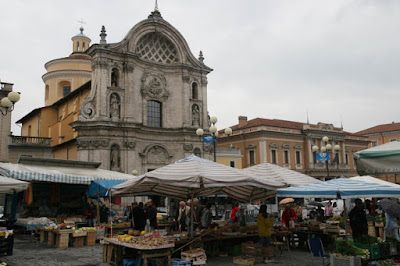Posts
Showing posts from 2015
Abruzzo: Lanciano
- Get link
- Other Apps

Ancient Anxanum, the city of the Frentanese, has contained for over twelve centuries the first and greatest Eucharistic Miracle of the Catholic Church. This wondrous Event took place in the 8th century A. D. in the little Church of St. Legontian, as a divine response to a Basilian monk doubt about Jesus' Real Presence in the Eucharist. During Holy Mass, after the two-fold consecration, the host was changed into live Flesh and the wine was changed into live Blood, which coagulated into five globules, irregular and differing in shape and size.The Host-Flesh, as can be very distinctly observed today, has the same dimensions as the large host used today in the Latin church; it is light brown and appears rose-colored when lighted from the back. The Blood is coagulated and has an earthy color resembling the yellow of ochre. Since 1713 the Flesh has been reserved in an artistic silver Ostensorium, delicately embossed by an artisan of the Neapolitan school. The Blood is enclosed in a
Abruzzo: L'Aquila
- Get link
- Other Apps

The Province preserves significant natural endowments, including the Abruzzo, Lazio and Molise National Park, the oldest park in Italy Due to its dimensions, it presents a great variety of customs and traditions, history and dialects, but an underlying thread runs ever through them. Because of such diversity, the people of Avezzano and Sulmona have long expressed their desire for independent provincehood. This is a small story of hope. Abruzzo, L'Aquila and its suburbs was almost destroyed in the night between 5 and 6 April 2009 from an earthquake of unimaginable violence. People, animals, houses and unrepeatable works of art, in 20 terrifying seconds, were deeply affected. These wounds cannot be be erased from the mind but the SOLIDARITY manifested by rescuers, opens a hope that is stronger than the pain. Here's a little story that proves it. The students who were the most affected, trying to retrieve their most important things from houses destroyed. But the building
Abruzzo: Santo Stefano di Sessanio
- Get link
- Other Apps

“Sessanio” or "Sextantia”, as it was called in Roman times, is the patron saint of the village. Many structures in the village date from the eleventh through fifteenth centuries. In the twelfth century, Santo Stefano was part of the Baronage of Carapelle, which included Castel del Monte, Colascio, Capestrano, Carapelle, Castelvecchio, Ofena, and Villa S.Luca. The still standing village portal and now destroyed circular tower (the town's most notable architectural landmark) were constructed by the Medicis. The entrance portal, which leads to the village's main square, is emblazoned with the Medici coat of arms. Other historic structures include the Church of Santa Maria in Ruvo, Casa Fortezza, the Church of Santo Stefano, the ruins of the Palazzo Anelli, the Church of Santa Maria delle Grazie, and the Convent S. Maria del Monte. The village's main source of income is tourism with small boutiques, art galleries and eateries tucked into ancient stone structures. A